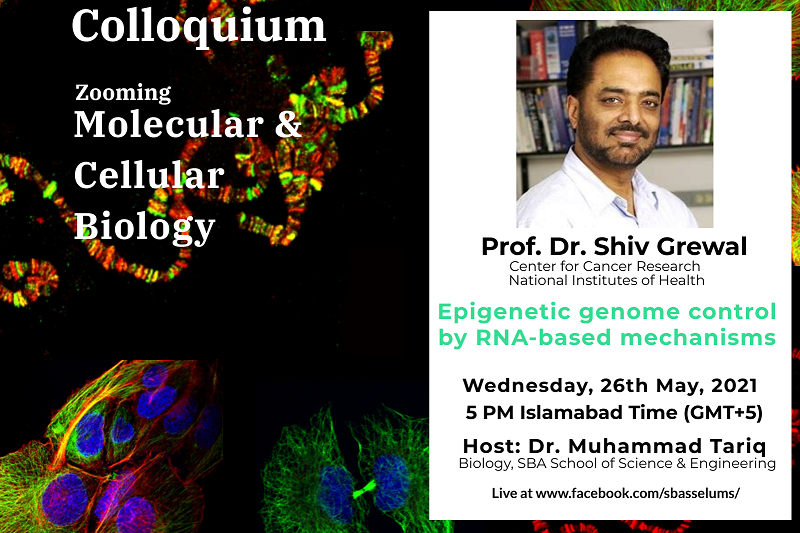
Epigenetic Genome Control by RNA-Based Mechanisms
• Wei, Y., Lee, M.N., Pan, L., Dhakshnamoorthy, J., Sun, L., Zofall, M., Wheeler, D., and Grewal S.I.S. (2021). TOR targets an RNA processing network to regulate faculttaive heterochromatin, developmental gene expression and cell proliferation. Nat. Cell Biol., 23:243-256.
• Holla, S., Dhakshnamoorthy, J., Folco, H.D., Balachandran,V., Xiao, H., Sun, L.L., Wheeler, D., Zofall, M., and Grewal S.I.S. (2020) Positioning heterochromatin at the nuclear periphery suppresses histone turnover to promote epigenetic inheritance. Cell 180; 150-164.
• Zofall, M., Yamanaka, S., Reyes-Turcu, F., Zhang, K., and Grewal, S.I.S. (2012). RNA elimination machinery targeting meiotic mRNAs promotes facultative heterochromatin formation. Science 335:96-100.
• Hall, I., Shankaranarayana, G., Noma, K., Ayoub, N., Cohen, A., and Grewal, S.I.S. (2002) Establishment and maintenance of a heterochromatin domain. Science, 297: 2232-2237.
• Nakayama, J., Rice, J., Strahl, B., Allis, C.D. and Grewal, S.I.S. (2001). Role of histone H3 lysine 9 methylation in epigenetic control of heterochromatin assembly. Science 292: 110-113.
Prof. Dr. Shiv Grewal is our next guest speaker in the Molecular and Cellular Biology Colloquium series. He will be talking about “Epigenetic Genome Control by RNA-Based Mechanisms” on 26 May 2021 at 1700 hours PST via Zoom.
Prof. Dr. Shiv Grewal is NIH Distinguished Investigator and currently serving as the Chief of the Laboratory of Biochemistry and Molecular Biology and the Head of the Chromosome Biology Section of the Center for Cancer Research, National Cancer Institute. Shiv is a discoverer who has spent his life to understand how switching ON/OFF mechanism of genes operates in living cells and how once these ON/OFF states are stably inherited during our development. He is known for his groundbreaking work which has revealed how open and highly condensed conformation of chromatin is established, maintained and inherited. Three papers from Dr. Grewal’s laboratory are cited for historic discoveries over the past 50 years by Nature. Dr. Grewal is the recipient of the prestigious Newcomb-Cleveland Prize, NIH Merit Award, and the NIH Directors’ award. He is a member of the US National Academy of Sciences, and the American Academy of Arts and Sciences.
Biography:
Shiv Grewal’s laboratory investigates conserved pathways involved in epigenetic genome control and assembly of heterochromatin, a specialized form of chromatin that impacts diverse cellular processes, including trans-generational inheritance of gene expression states, chromosome architecture, and the maintenance of genome stability. Grewal’s early work uncovered the paradigm of molecular signatures, such as distinct histone methylation patterns, which denote alternative chromatin states and are the foundation of epigenetic gene regulation essential for the translation of genetic information. His work provided critical evidence for the histone code hypothesis by showing that methylation of histone H3 lysine 4 or 9 (H3K4me and H3K9me) define “open” and “closed” chromatin domains. He discovered that heterochromatic structures can be epigenetically inherited in cis through mitosis and meiosis illustrating that the Mendelian unit of inheritance sometimes constitutes DNA plus associated protein complexes.
He further revealed mechanisms that promote stable propagation of heterochromatin. In particular, he defined two fundamental features,
- the inherent property of heterochromatin to suppress histone turnover and
- the ability of histone modifiers to both “write” and “read” methylated histones, which are critical for epigenetic inheritance of heterochromatin.
Dr. Grewal’s and colleagues also discovered a highly conserved connection between RNAi and heterochromatin assembly that has revolutionized the current thinking on how complex genomes are assembled into higher-order chromatin structures. This important contribution was selected as Breakthrough of the Year 2002 by Science magazine. Three papers from Dr. Grewal’s laboratory are cited for historic discoveries over the past 50 years by Nature. Dr. Grewal is the recipient of the prestigious Newcomb-Cleveland Prize, NIH Merit Award, and the NIH Directors’ award. He is currently serving as the Chief of the Laboratory of Biochemistry and Molecular Biology and the Head of the Chromosome Biology Section of the Center for Cancer Research, National Cancer Institute. He is a member of the US National Academy of Sciences, the American Academy of Arts and Sciences, and a foreign fellow of the Indian National Science Academy.

